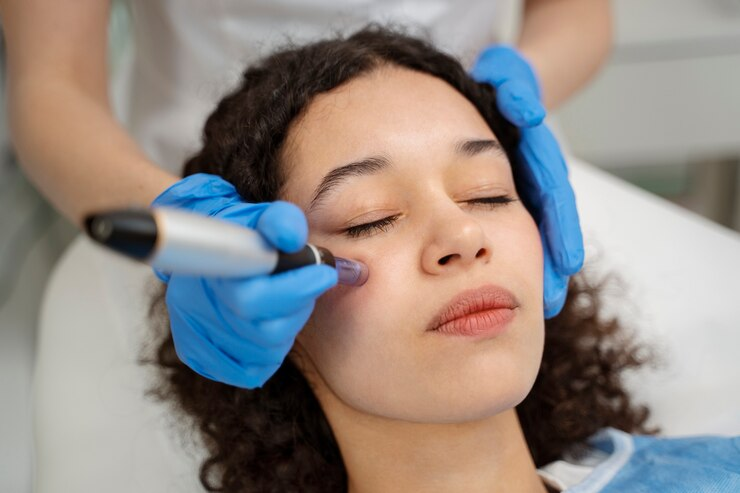Under eye pigmentation, often referred to as dark circles, is a common cosmetic concern affecting people of all ages and skin types. While it may not pose any health risks, it can impact one’s appearance and self-confidence.
Understanding the various treatment options available and how to choose the right one for you is essential for achieving the best results. This article delves into the causes of under eye pigmentation, explores different treatment options, and provides guidance on selecting the most suitable treatment for your needs.
Understanding Under Eye Pigmentation
Under eye pigmentation, commonly known as dark circles, can result from genetics, aging, lack of sleep, allergies, sun exposure, and lifestyle factors. Identifying the type—vascular, pigmented, structural, or mixed—is crucial for choosing an effective treatment.
For professional under eye pigmentation treatment, consider experts like Moyem Medical Aesthetics.
What Causes Under Eye Pigmentation?
Under eye pigmentation can result from various factors, including:
- Genetics: If your family members have dark circles, you are more likely to develop them.
- Aging: As you age, the skin under the eyes becomes thinner, making blood vessels more visible.
- Lack of Sleep: Sleep deprivation can cause the skin to become dull and pale, allowing dark tissues and blood vessels beneath the skin to show.
- Allergies: Allergic reactions can cause itching, rubbing, and scratching of the delicate skin around the eyes, leading to pigmentation.
- Sun Exposure: Excessive sun exposure can increase melanin production, leading to pigmentation.
- Lifestyle Factors: Poor diet, dehydration, and smoking can contribute to the development of dark circles.
Types of Under Eye Pigmentation
Identifying the type of under eye pigmentation is crucial for choosing the right treatment. The main types include:
- Vascular Dark Circles: Caused by blood vessels under the skin, these circles have a bluish or purplish tint.
- Pigmented Dark Circles: Result from excess melanin production and have a brownish appearance.
- Structural Dark Circles: Caused by the shadow effect due to the anatomical structure of the eye area.
- Mixed Dark Circles: A combination of the above types, requiring a multi-faceted treatment approach.
Treatment Options for Under Eye Pigmentation
There are several treatment options available for under eye pigmentation, ranging from home remedies to professional medical treatments. Here’s a closer look at some of the most effective options:
Home Remedies
- Cold Compresses: Applying a cold compress can help reduce swelling and shrink dilated blood vessels, diminishing the appearance of dark circles.
- Cucumber Slices: Cucumbers have skin-lightening and mild astringent properties. Placing cucumber slices on the eyes can soothe and lighten the skin.
- Tea Bags: Caffeinated tea bags, when chilled and placed on the eyes, can help reduce dark circles due to their antioxidant properties and tannins that improve blood circulation.
- Aloe Vera: Aloe vera has anti-inflammatory and moisturizing properties, making it beneficial for treating dark circles.
Over-the-Counter Products
- Eye Creams: Eye creams containing ingredients like vitamin C, retinol, hyaluronic acid, and peptides can help reduce pigmentation and improve skin texture.
- Brightening Serums: Serums with ingredients like niacinamide and kojic acid can help lighten pigmentation over time.
Professional Treatments
- Chemical Peels: Chemical peels use acids to exfoliate the top layer of skin, promoting new skin growth and reducing pigmentation. They can be effective for pigmented dark circles.
- Laser Therapy: Laser treatments target melanin and blood vessels under the skin, helping to reduce pigmentation and improve skin tone.
- Dermal Fillers: For structural dark circles, dermal fillers can add volume and reduce the shadow effect, making the area appear brighter.
- Microneedling: Microneedling involves creating tiny punctures in the skin to stimulate collagen production, which can help improve skin texture and pigmentation.
- Platelet-Rich Plasma (PRP) Therapy: PRP therapy uses your blood’s platelets to promote healing and rejuvenation in the under-eye area, improving pigmentation and skin quality.
How to Choose the Right Treatment for You
Choosing the right under eye pigmentation treatment involves considering several factors, including the cause of your dark circles, your skin type, and your budget. Here’s a step-by-step guide to help you make an informed decision:
- Identify the Cause: Understanding the underlying cause of your under eye pigmentation is the first step. Consider factors like genetics, lifestyle, and any medical conditions that might be contributing to the problem.
- Determine Your Skin Type: Your skin type plays a crucial role in determining the best treatment. For instance, those with sensitive skin may need to avoid certain chemical peels or laser treatments that could cause irritation.
- Consult a Dermatologist: A dermatologist can provide a professional assessment of your under eye pigmentation and recommend the most suitable treatment options. They can also perform patch tests to ensure you don’t have adverse reactions to certain treatments.
- Evaluate the Effectiveness and Side Effects: Research the effectiveness and potential side effects of each treatment option. While some treatments offer quick results, they might come with a higher risk of side effects. Others might be safer but require a longer time to show results.
- Consider Your Budget: Professional treatments like laser therapy and dermal fillers can be expensive. Evaluate your budget and consider whether you can commit to multiple sessions if needed.
- Look for Reviews and Testimonials: Reading reviews and testimonials from others who have undergone the same treatment can provide valuable insights into its effectiveness and potential side effects.
- Start with Less Invasive Options: If you’re unsure about which treatment to choose, start with less invasive options like home remedies or over-the-counter products. If these don’t yield satisfactory results, you can then explore professional treatments.
Step-by-Step Guide to Selecting Your Treatment
Step 1: Self-Assessment
Begin with a thorough self-assessment to understand your under eye pigmentation. Note any lifestyle factors, such as sleep patterns and diet, that might be contributing to the problem.
Step 2: Research Treatment Options
Research various treatment options, including home remedies, over-the-counter products, and professional treatments. Make a list of potential treatments that you are interested in.
Step 3: Schedule a Dermatologist Appointment
Book an appointment with a dermatologist to discuss your concerns and treatment options. Bring your list of potential treatments and ask for their professional opinion.
Step 4: Patch Test
For topical treatments, ask your dermatologist to perform a patch test to ensure you don’t have an adverse reaction to any ingredients.
Step 5: Start Treatment
Begin with the treatment option recommended by your dermatologist. Follow their instructions carefully and be consistent with the treatment regimen.
Step 6: Monitor Progress
Keep track of your progress by taking before and after photos. Note any changes in pigmentation and skin texture.
Step 7: Evaluate and Adjust
If you don’t see significant improvement after a reasonable period, consult your dermatologist again. They may suggest adjusting the treatment plan or trying a different approach.
Conclusion
Choosing the right under eye pigmentation treatment involves understanding the underlying causes of your dark circles, evaluating various treatment options, and consulting with a dermatologist.
By following a step-by-step approach, you can identify the most effective treatment for your specific needs and achieve a brighter, more youthful appearance. Under eye pigmentation is a common concern, but with the right approach and treatment, it is possible to reduce and even eliminate dark circles.
Whether you opt for home remedies, over-the-counter products, or professional treatments, consistency and patience are key to achieving the best results. Always consult with a dermatologist to ensure the treatment you choose is safe and suitable for your skin type.
Stay in touch to get more updates & news on essentialtribune!









